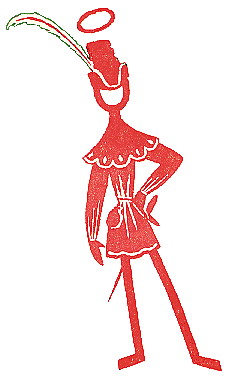|

Article Page 1
Article Page 2
Article Page 3
Article Page 4
Article Page 5
Bibliography
Cover Gallery 1
Cover Gallery 2
Cover Gallery 3
Cover Gallery 4
Cover Gallery 5
Cover Gallery 6
Cover Gallery 7
German covers by Regino Bernad
Le Saint Detective Magazine 1
Le Saint Detective Magazine 2
Le Saint Detective Magazine 3
Le Saint Detective Magazine 4
About Nero Wolfe & The Toff
About artist
Regino Bernad
The Saint on French Radio
French-English
Text Comparisons
De Saint (The Dutch Saint)

© 2001 Jean-Marc Lofficier. This article first appeared in a slightly different form in the Summer '94 issue
of The Epistle.
Thanks to Ian Dickerson for Research Assist.
Thanks to Dan Bodenheimer, Marcel Bernadac, and Patrick Verdant for additional cover scans.

|
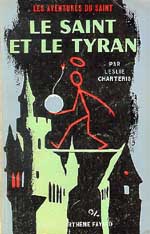 4. The "comic stories" - second period (1959-1963) 4. The "comic stories" - second period (1959-1963)
As we said, the quality and interest of the French pastiches went
up markedly in 1959, with some of the most interesting books published later in the series.
Certainly, Leslie Charteris' further and continued intervention may have been one of the reasons. Another is the
possible intervention of renowned science fiction writer Harry Harrison who claims to have been involved with the
New York Herald-Tribune strips
during the years 1955-1961. This is what Mr. Harrison said in an interview:
"I was writing book reviews for The Saint Magazine under Leslie Charteris' name for a small amount of money. I got to do it through a friend
of mine, Hans Stefan Santesson, an author who edited Fantastic Universe. Leslie Charteris was doing a comic strip of The
Saint and I had comics experience, so I did some outlines and he liked
them, and I started working with him doing the comic strips. The scripts were very long, about three months of
daily comic, and a number of these were taken by a girl in Paris [Madeleine Michel-Tyl] who wrote them up as novels...
[Interviewer's question: She ghosted Saint
novels?] From my ghosted comic scripts! There are more Saint books in France than there are in America, so a number of my scripts appeared in France
as novels, but never in the States. One of the reasons the strip was killed was because the stories were so long
- there should only be three or four weeks in a series for people's attention span. These were three months long
- the girl could eventually write a novel from them. So eventually the strip was killed. At that time I had one
or two outlines that I had done for comic strips, and I went to see Leslie and he said would you like to expand
this into a novel?"
... and Mr. Harrison then goes on describe how he wrote Vendetta for the
Saint (1964).
Meanwhile, No. 58, entitled The Saint and the Tyrant,
took place in the fictional South American republic of Escudia (Escoria in the NYH-T strip), where Simon helps rebel leader Dr. Cortes overthrow the local tyrant, Borgaz,
and his accomplice, Valdinez.
The next volume, Hell Awaits the Saint
(No. 59), turned out to be a thrilling pseudo-SF horror story taking place in Haiti. There, Simon defeats a mad
scientist, Dr. Zoran, whose rejuvenating machine produces brainless zombies. The descriptions of Zoran's underground
citadel are particularly colorful. Hell Awaits the Saint was definitely one of the most exciting books of this period.
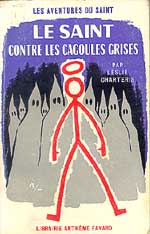 Another very good
novel immediately followed, which also made use of a pseudo-SF device. In The
Saint vs. the Grey Hoods (No. 60), Simon fights the evil Colonel Graw,
ring leader of a paramilitary gang of thieves, the Grey Hoods (the Gray Ghosts in the NYH-T strip), who use infra-red glasses to commit burglaries during foggy British nights. It
was a properly moody, violent book, yet with all the wry humor associated with the Saint. Another very good
novel immediately followed, which also made use of a pseudo-SF device. In The
Saint vs. the Grey Hoods (No. 60), Simon fights the evil Colonel Graw,
ring leader of a paramilitary gang of thieves, the Grey Hoods (the Gray Ghosts in the NYH-T strip), who use infra-red glasses to commit burglaries during foggy British nights. It
was a properly moody, violent book, yet with all the wry humor associated with the Saint.
Next came The Saint in Paris (No.
61), in which Simon fights the villainous Russian spymaster Varon to save a beautiful French scientist, Marie Latour.
France's answer to Teal, and Simon's French nemesis, the hound-like Inspector Quercy, is featured in this novel.
In No. 62, Let's Sacrifice the Saint,
Simon is hired by the Gem Merchants Protective Association to thwart the goals of Inga Rolf, a.k.a. Greta Morgan,
and her accomplice, Toff Lyken, who have located a lost Inca tribe in Amazonia, and are using local superstitions
to steal their treasure of precious emeralds.
The series continued with Thanks to the Saint,
a translation of Charteris' 1957 collection (released in France in 1960). The next novel, No. 64, the title of
which translates as The Saint Lies In Wait,
had as interesting a story as Bet on the Saint.
It is, in fact, an alternate version of another Charteris/Fleming Lee collaboration, published in English as The Saint in Pursuit. The story behind this novel
is told in Barer's book (pages 175-176). Its plot has Simon travelling from Lisbon to Switzerland to help young
Vicky Kinian claim her late father's inheritance (he was an OSS agent). The villain is a murderous Russian spy
named Uzdanov. A French motion picture with the same title was released by Intermondie in 1966, bearing little
if any resemblance to the book, even though it purported to adapt it. Barer describes the various legal battles
which ensued between Charteris and the producers (pages 136-138).
No. 65, entitled The Saint in the Water,
moved the action to the Bahamas. In it, Simon fights two villains, Garwell and Luzik, to help his friend Dan Morrow
find an underwater treasure.
Then, we were back in England in The Saint Behind the Wheel (No. 66), where the Saint takes part in a cross-country race to protect young automobile
engineer Ian Foyle and his fiancée Margaret from the evil schemes of her cousin Charles.
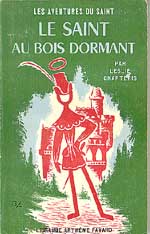 A straightforward
translation of Señor Saint,
entitled No Holidays for the Saint
(No. 67), followed, and then Fayard released one of Michel-Tyl's best efforts, The
Saint in Sleeping Beauty's Castle (No.68). A straightforward
translation of Señor Saint,
entitled No Holidays for the Saint
(No. 67), followed, and then Fayard released one of Michel-Tyl's best efforts, The
Saint in Sleeping Beauty's Castle (No.68).
This book takes place in the South of France, which is portrayed witch such charm and local color that one suspects
that Leslie Charteris himself had more than a passing involvement in it. Indeed, Mrs. Charteris confirmed that
the castle in which the story takes place was inspired by a real castle that she and her husband saw on several
of their trips to the South of France. The plot is extremely clever. Simon faces Sir Charles, a British nobleman
who has kept his niece, Wendy, living in a fairy tale castle, Château Sorcelou, all her life so that he can
have her committed when she turns eighteen, and keep her considerable inheritance for himself. Needless to say,
Simon inadvertently uncovers the scheme and breaks into the castle. Wendy, who is now a budding young woman, sees
in him the Prince Charming of the stories which are, to her, reality. The
Saint in Sleeping Beauty's Castle is a wonderfully written novel, charming,
whimsical and yet deadly serious at the same time. It is a high point in the series, a tribute to the excellent
collaboration between Charteris and Madeleine Michel-Tyl.
Fayard followed with The Trumps of the Saint
(No. 69, 1962), an original collection gathering more stories which had not been previously collected in The Saint Has Fun (No. 24). Why it took Fayard
six years to collect these remains a mystery. The Trumps of the Saint contains one story from The Brighter Buccaneer (The Unpopular Landlord),
seven stories from The Saint Intervenes
and two stories from The Happy Highwayman.
As indicated above, some stories still remained untranslated, and would finally be used almost at the very end
of the series, in No. 76.
This was the point in the series when Fayard was finally able to acquire the rights to the two seminal Saint novels, Meet
the Tiger! and The Last Hero, which had been, until then, Gallimard's property. These two were now released, respectively
as No. 70 (Meet the Tiger! being
rechristened The Saint and Patricia)
and No. 72.
The departure in style was rather abrupt, since in these two books, Simon is portrayed as a youthful adventurer.
The novels also clearly take place before the war. On the other hand, in her more recent efforts, Madeleine Michel-Tyl
had carefully aged Simon, so that he had become a more mature hero -- not unlike the Roger Moore character in the
television series, which was posterior to Michel-Tyl's novelisations. And, of course, the plots took place in a
contemporary setting. The absence of specific notes to the reader that should have indicated that these were early
Saint adventures -- a definite
Fayard editorial lapse -- meant that one had to rely on internal clues and knowledge of the earlier books in the
series to make sense of their place in the Saint
chronology.
In between these two "classics", Fayard sandwiched yet another excellent Michel-Tyl's adaptation, The Saint in Mexico (No. 71), in which Hamilton
sends Simon to Mexico to deal with Inky Schatz, a talented forger of fake dollars. But Schatz has associated himself
with a terrific villain, El Tigre. Simon infiltrates El Tigre's gang, and eventually defeats the Mexican bandit
and brings Schatz back to the U.S. The Saint in Mexico is a terrific thriller.
It was followed by The Saint in Africa
(No. 73). The action took place in the fictional African republic of Kanaba, where Simon defeats Dr. Bogan and
his henchman Weedy to help a missionary, Dr. Grey. It turns out that Bogan seeks the secret of a miracle drug,
known only to the local tribe, the Zikus. Not unsurprisingly, Simon eventually becomes the new chief of the Ziskus.
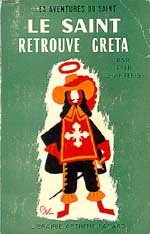 The next volume
in the series, No. 74, was yet one more translation of a Charteris' short story collection, this time The Saint to the Rescue. It was followed by the
last of the Michel-Tyl's pastiches, appropriately entitled The Saint Meets
Greta Again (No. 75) -- and one could have added, for the last time. This
somewhat melancolic, but otherwise excellent, novel took place again on the French Riviera. This time, Simon thwarts
a new plot by Greta Morgan, who steals famous paintings and threatens to destroy them unless insurance companies
pay her ransom money. Even though Simon eventually outwits Greta, this is the closest he has ever come to feel
more than a passing fancy for her. And when the two enemies part, there is a genuine sense of sadness. The next volume
in the series, No. 74, was yet one more translation of a Charteris' short story collection, this time The Saint to the Rescue. It was followed by the
last of the Michel-Tyl's pastiches, appropriately entitled The Saint Meets
Greta Again (No. 75) -- and one could have added, for the last time. This
somewhat melancolic, but otherwise excellent, novel took place again on the French Riviera. This time, Simon thwarts
a new plot by Greta Morgan, who steals famous paintings and threatens to destroy them unless insurance companies
pay her ransom money. Even though Simon eventually outwits Greta, this is the closest he has ever come to feel
more than a passing fancy for her. And when the two enemies part, there is a genuine sense of sadness.
The Saint Meets Greta Again, released
in December 1963, marked the creative end of the Fayard Saint series and of the Charteris-Michel-Tyl collaboration. From several books a year, the rhythm
of publication now fell to two, then one. The reasons for this decline are unclear, as the popularity of the Saint, boosted by the television series, was on
the rise again. Certainly, Fayard actively marketed its considerable backlist during the next six years. But no
more pastiches were published, and the series itself, as we shall see, was soon discontinued.
PART 5 TO BE CONTINUED ON NEXT PAGE:

|
